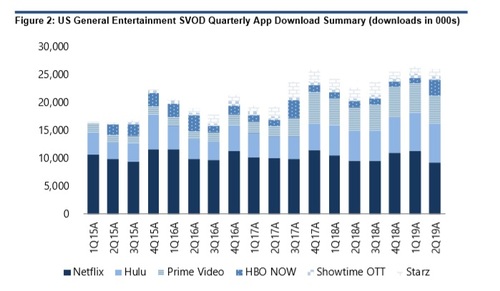 Source: Crunchyroll
Source: Crunchyroll
As more people start to take control of their viewing experience, opting for freedom, flexibility, and choice - droves of new consumers are flocking to SVoD services.
Standalone SVOD vs vMVPDs
Before I start, just a short "explain the weird abbreviation" pause for that I promised to myself dedicated to new readers.
A vMVPD is a service that provides multiple television channels through the internet without supplying its own data transport infrastructure. These services are also sometimes called “skinny bundles” and Sling TV, DirecTV Now, PlayStation Vue, Fubo and Philo are some of the most popular ones.
Studies show that in the last three quarters, there has been a significant rise in direct-to-consumer SVoD app downloads.
 Source: Company data, Evercore ISI research, SensorTower
Source: Company data, Evercore ISI research, SensorTower
This spike seems to fill the void left by the declining vMVPD downloads. Amid rising price increases, the appeal of virtual MVPD services is slowing, showing a 34% year-on-year drop. On the contrary, standalone SVoD apps - particularly HBO’s offering during the airing of Game of Thrones’ epic final season - have risen, with big players like Netflix, Amazon Prime, and Showtime shows a 15% rise in adoption, collectively.
Experts like Mike Berkley, TDG’s senior advisor and author of the report -- The Future of Direct-to-Consumer Video Services - Analysis & Forecasts, 2018-2028 – claims that there are “early signs of an emerging media tribalism.”
This trend is a major hurdle for market reaggregation
It seems that today’s video-hungry consumers are commanding the reaggregation of video services to enjoy the existing level of service and usability with the added benefit of consolidated content libraries.
The reaggregation of video services (or Pay TV 3.0) is being mentioned quite a lot nowadays. The thing is, it will be super hard to bring everyone back under one roof. The reason? Data.
But, the road to reaggreation is paved with roadblocks - of the data-driven kind. Many direct-to-consumer platforms will be reluctant to share the data they currently control to influence personalisation and content programming decisions.
Success factors for direct-to-consumer video services
The key to direct-to-consumer success lies in market positioning and understanding your audience on a deeper, more personal level.
With three new notable direct-to-consumer services launching this year - Disney+, Apple TV+ and Warner Media service - it’s clear that direct-to-consumer services are fast becoming a pivotal part of the modern viewing experience.
By going direct-to-consumer and understanding your audience’s needs exactly, you stand to yield impressive results in terms of viewership, brand awareness, and revenue.
It will be interesting to see how the three direct-to-consumer giants mentioned above will perform this year - but while that’s yet to be decided one thing’s for sure, this model is valuable, viable, and built to last.



